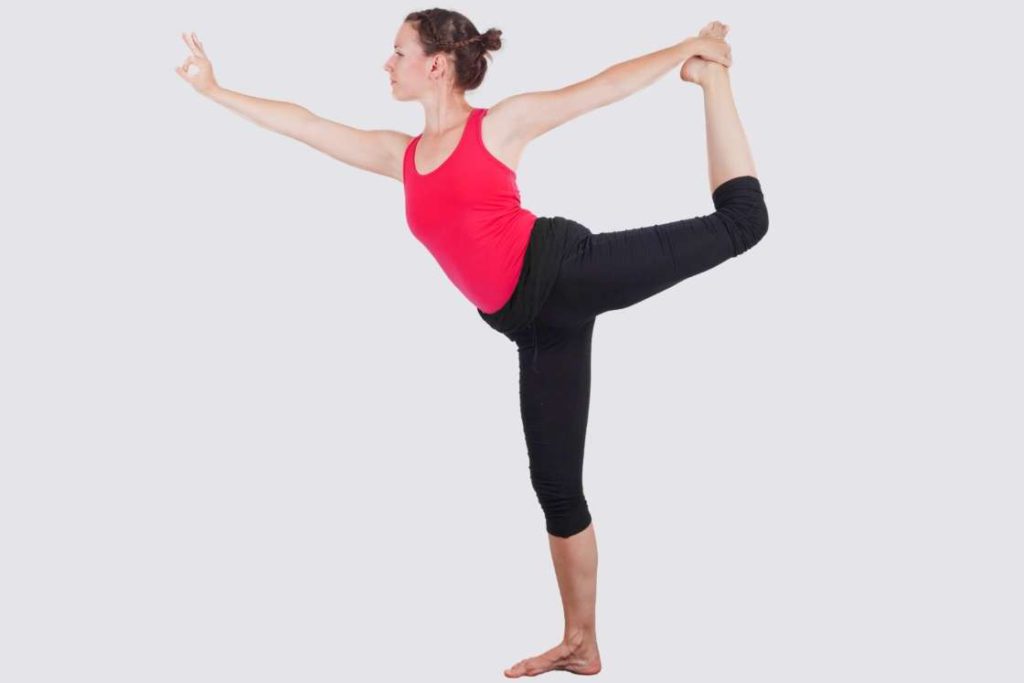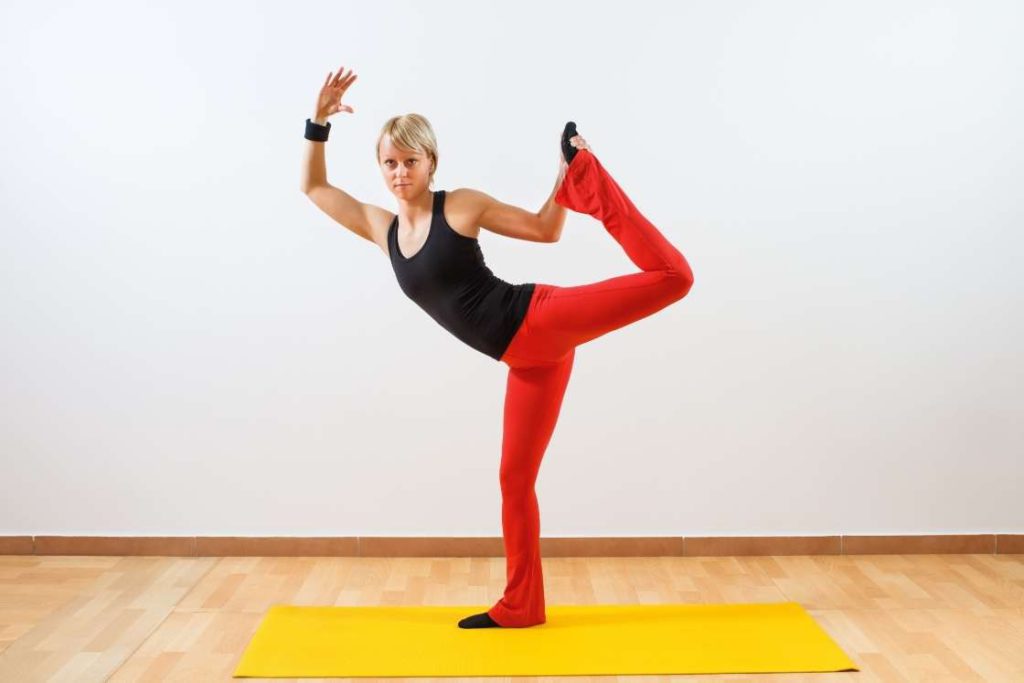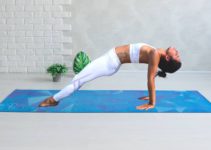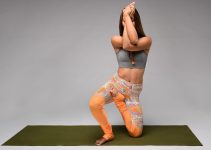
Natrajasana is a graceful yogic move to improve the balance and posture of the body. It is attributed as a spiritual practice that involves dedication, hope, and prepares the practitioner to understand life clearly.
It is performed standing on one leg, hence requires strength and balance. The spine muscles are stretched and bent backward. The backbend along with the intense stretching movements makes it a challenging pose to hold. Therefore, it is an intermediate level pose.
Getting into the pose requires balancing the body on one leg while the other leg is lifted and bent at the knee. The lifted leg is pulled behind the body with the corresponding hand drawing the foot towards the head. The other arm is also lifted at the shoulder level to reach up while leaning forward.
It targets the spine, hip, leg, and arm muscles. Apart from these, it strengthens core muscles, opens the chest, and improves flexibility.
Natarajasana Meaning
Natarajasana comprises three root terms that signify the posture. Here, “nata” means “dancer, “raja” is “king” or “lord”, and “asana” refers to “pose”.
Shiva was also known to be the Lord of the dance and referred to as Nataraja, therefore the pose is dedicated to him, hence the name.
It is widely known by the English names, Dancer pose, lord of the dance pose, or king dancer pose.
Apart from being a yogic posture, this is also performed as a move in Indian classical dance, Bharatanatyam.
Symbolic representation of natarajasna
Besides grace, Shiva also represents the liberation of fears. Performing natarajasana is all about challenging your comfort zone by overcoming the fears.
In this practice, the yogi is supposed to challenge the balance by holding the posture in one leg at a time. Simultaneously, the gesture involves back bending. These two forces bring fear of falling altogether, however, it could be overcome by opening the heart followed by back bending.
Therefore, natarajasana is all about gracefully overcoming the challenges, thereby, improving the willpower and concentration to find balance.
Natarajasana Practice Guide

Contraindications
- Avoid this pose if you have an injury in the legs, groins, hips, or shoulders.
- Patients of arthritis must avoid this pose.
- People suffering from severe back pain, slipped disc, or the bulging disc must avoid this asana.
- Practice its modified version only, if you have a poor balance.
- Do not practice it if you are experiencing sacroiliac pain.
- Avoid it if you are suffering from low blood pressure.
- People with carpal tunnel syndrome must refrain from this pose.
Preparatory Poses
Practice these basic postures to improve balance while standing on one leg and bending backward. These poses provide flexibility to the body that eventually prepares you for Natrajasana.
- Handstand Pose (Adho Mukha Vrksasana)
- Bow Pose (Dhanurasana)
- One-Legged King Pigeon Pose (Eka Pada Rajakapotasana)
- Cow Face Pose (Gomukhasana)
- Monkey Pose (Hanumanasana)
- Reclining Hero Pose (Supta Virasana)
- Reclining Hand-to-Big-Toe Pose (Supta Padangusthasana)
- Upward-Facing Bow Pose (Urdhva Dhanurasana)
How to Do Natarajasana

- Stand in tadasana gazing forward to a fixed point.
- Shifting the weight on the left leg, bend the right knee flexing the right foot backward.
- Hold the right big toe with the right thumb, index, and middle fingers.
- Keep the left leg straight and firm to the floor.
- Swivel the right shoulder to point the elbow upwards pulling the right foot towards the head.
- Simultaneously, raise the left arm forward aligned with the shoulder.
- Extend the spine and left arm to lean forward and reach upward.
- Join the tip of the index finger and thumb of the left hand to form jnana mudra.
- Hold the pose for 10-15 seconds breathing deeply and keeping the eyes fixed on the fingers of the left hand.
- Lower the left arm to the side and release the right foot to the floor.
- Relax in tadasana for a few seconds.
- Repeat it to the other side.
Precautions
- While lifting the foot and pulling it backward do not twist the corresponding hip.
- Neither lock nor overbend the knee of the standing leg while holding the pose. Engaging the quadriceps muscles will keep the knee soft.
Follow-up Poses
Following natrajasana, relax the spine, shoulders, arms, and legs performing the following poses and stretches. Before relaxing poses move your legs and kick from the knees to activate the leg muscles. Twist the shoulders, chest, and arms.
- Standing half forward bend (ardha uttanasana)
- Bowing yoga mudra
- Wild Child Pose (Parasarita Balasana)
Props and Modifications
- Natarajasana with Chair- Place a chair in front of you with its back towards you. Place your hand on the top of the chair for support. Then, lift the alternate foot grabbing the toe with the hand.
- Yoga strap- Hold a strap in front of you and bring it to the floor. Step your right foot on it and cross the strap to form a loop around the foot. Pull the strap backward to lift the foot, holding the strap with both hands, and bring the foot behind the head. You can also stand behind the chair leaning on the chair’s back to prevent collapsing forward.
- Against a Wall- Stand in tadasana facing a wall maintaining one-hand distance. Lift the right leg bending the knee to grab the foot and pull it backward. Extend the left arm forward reaching the wall with fingertips. Gradually try to increase the distance between the wall and you. Beginners should try this modification to build balance and confidence.
Variations
- Saral Natarajasana – Stand in tadasana. Bend your right knee bringing the foot backward. Hold the lifted ankle with the right hand. Pull the leg up behind the body as much as comfortably possible. Raise the left arm forward to reach upward with thumb and index finger forming jnana mudra.
- Natrajasana B – After attaining the natarajasana holding the right foot behind the head draw your left arm backward. Pointing both the elbows upward hold the right foot with both hands. Pull it further to rest the foot on the head gazing upward.
- Dancer Pose Mermaid Variation – From tadasana bend the right knee holding the foot with the right hand behind the body. Bend the right elbow to shift the foot from hand to the elbow crook. Lean forward and simultaneously pull the leg up with the right arm. Raise the left arm forward and bending the left elbow reach back to grab the fingers of the right hand.
- Natarajasana II – Stand with right leg bent at the knee holding the foot with left hand behind the body. Bend forward on your hips keeping the spine erect. Reach the floor with the fingertips of the right hand.
- Nantum Natarajasana – After holding the right big toe with the right hand behind the body flex the right elbow upward. Lean forward keeping the upper body parallel to the floor.
Therapeutic Use
- This graceful pose requires balance and concentration. Hence it exercises the brain and brings calm to the mind. Thus, it helps relieve stress.
- Practicing natarajasana alleviates the hunch in the back, and stretches the shoulders hence beneficial in improving body posture.
- The stretch involved in natarajasana is a hip-opener. This rectifies any hip misalignment or disorders. It is therapeutic for piriformis syndrome or pain in the buttock region.
Natarajasana Benefits
1. Improves legs strength
Pulling the leg behind the back intensely stretches the ankle, claves, and hamstring muscles. The quadriceps of the supporting leg is also actively engaged to hold the pose. It strengthens the legs and improves their flexibility.
2. Tones the arms
The arm muscles are also stretched and exercised to perform natarajsana. It improves the blood circulation to the arms and tightens the arm muscles by shedding extra fat layer around the arms. Hence provides toned arms.
3. Stimulates the hip flexors
This asymmetric pose is also beneficial for the hip muscles. It stretches the hips and acts as an incredible hip-opener. It eventually enhances the flexibility of hips flexors.
4. Improves spine flexibility
The spine is majorly exercised while holding the pose. The lower back is stretched to increase the natural arch. Further, the middle and upper spine is lengthened. It expands the back muscles and entire spine lengthening from the crown of the head. Therefore improves overall flexibility.
5. Enhances breathing capacity
Natarjasana is performed leaning forward and reaching upward that opens the chest and shoulders. These movements expand the lungs’ volume and increase breathing capacity. Hence, the pose is also beneficial to improve the efficiency of the respiratory system.
6. Stimulates core muscles
The core is expanded while performing natarajasana. The stretch in the core muscles also stimulates the abdominal organs, improves digestion, and tones the abdomen. Hence it is also an important asana to reduce weight.
7. Regulates metabolism
Natrajasana involves stretching of the neck muscles. This activates the thyroid gland and secretes thyroid hormones. It regulates the overall metabolism of the body.
8. Improves balance
The pose is performed standing on one leg. The entire body weight is shifted towards one leg and it opens the brain thereby improving the concentration. This helps in gaining better body balance.
Conclusion
Perform natarajasana to overcome all your fears and experience liberation. Besides rejuvenating the body and mind, practice this pose to take the challenges of life without losing your grip.




